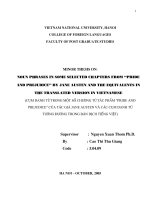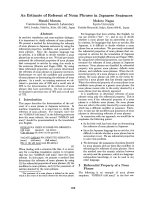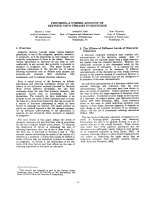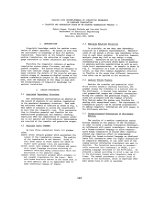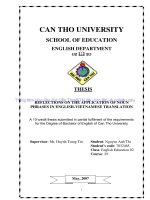Strategies dealing with translating technical noun phrases in electronics texts
Bạn đang xem bản rút gọn của tài liệu. Xem và tải ngay bản đầy đủ của tài liệu tại đây (407.97 KB, 5 trang )
ISSN 1859-1531 - TẠP CHÍ KHOA HỌC VÀ CÔNG NGHỆ ĐẠI HỌC ĐÀ NẴNG, SỐ 8(129).2018
5
STRATEGIES DEALING WITH TRANSLATING TECHNICAL NOUN PHRASES
IN ELECTRONICS TEXTS
CÁC CHIẾN LƯỢC DỊCH CỤM DANH TỪ KỸ THUẬT TRONG
VĂN BẢN NGÀNH ĐIỆN TỬ
Nguyen Thu Hang
University of Foreign Language Studies - The University of Da Nang;
Abstract - This study aims at determining structural patterns of
English noun phrases in general and in electronics texts in particular
and analyzing differences in word order between English noun
phrases and Vietnamese counterparts. Moreover, various translation
strategies suggested by scholars are taken into consideration, which
lays the foundation for the translation of technical noun phrases. What
is more, it investigates the common strategies students majoring in
electronics at a university in Vietnam use in dealing with translating
technical noun phrases in electronics texts. Above all, it puts forwards
thoughtful recommendations for the effective translation of technical
noun phrases in English electronics documents. Findings from the
study can contribute to research in the field of compilation and
interpretation of technical documents in general.
Tóm tắt - Bài nghiên cứu này nhằm xác định cấu trúc của cụm
danh từ kỹ thuật tiếng Anh nói chung cũng như trong tài liệu ngành
điện tử nói riêng và phân tích sự khác biệt về trật tự từ giữa cụm
danh từ tiếng Anh và tiếng Việt. Hơn thế nữa, các chiến lược dịch
thuật của các học giả trên thế giới cũng được xem xét để tạo cơ
sở lý thuyết cho việc dịch các cụm danh từ kỹ thuật trong loại văn
bản này. Ngoài ra, bài báo cũng khảo sát các chiến lược dịch thuật
mà sinh viên chuyên ngành điện tử tại một trường đại học ở Việt
Nam dùng để dịch các cụm danh từ này. Trên tất cả, bài báo đề
xuất các giải pháp để việc dịch cụm danh từ kỹ thuật trong văn bản
ngành điện tử được hiệu quả hơn. Kết quả nghiên cứu có thể đóng
góp vào những nghiên cứu liên quan đến công tác biên - phiên dịch
tài liệu kỹ thuật nói chung.
Key words - noun phrases; translation; translation strategies;
electronics texts; technical documents
Từ khóa - cụm danh từ; dịch thuật; chiến lược dịch thuật; văn bản
ngành điện tử; văn bản kỹ thuật
1. Rationale
Danang University of Science and Technology (DUT)
witnesses the high demand for crucial skills among
students as engineers-to-be who are challenged by
numerous difficulties in understanding and translating
technical texts. Technical documents, characterized by
their precise and logical description of science, may be
abounded with numerous noun phrases.
This study aims at finding out structural patterns of
English noun phrases in general and in electronics texts in
particular and determining differences in word order
between English noun phrases and Vietnamese counterparts.
Moreover, various translation strategies are under
discussion, which paves the way for the translation of
technical noun phrases in the genre. Besides, it investigates
the common strategies students majoring in electronics at
DUT use in dealing with translating technical noun phrases
in electronics texts. Above all, it puts forwards thoughtful
recommendations for the effective translation of technical
noun phrases in English electronics documents.
and technical documents are characterized by the
description of phenomena, objects and process.
Notably, in the scope of the study, it is worthwhile
bearing in mind that the NPs in this study are technical ones
in electronics texts, which are different from NPs that
denote non-technical concepts.
The meanings of technical terms are closely associated
with a particular subject area and the best way to determine
this for any word is to use a rating scale that categorizes
words according to how closely related they are to a
particular subject area (Baker, 1988; Farrell, 1990;
Sutarsyah, Nation & Kennedy, 1994). This can be done
using a technical dictionary compiled by a subject specialist
or a group of specialists (Nation, 2001; Oh et al., 2000).
Noun phrase is a phrase, which has noun or pronoun as
its head (Morley, 2000). Halliday (1985) explains that
constituents which modify the head noun and appear before
the head noun are called pre-modifiers whereas the
modifiers placed after the head of noun phrase are called
post-modifiers.
2. Theoretical framework
2.1. An overview of NPs and technical terms
As Newmark (1988a) assumes, technical translation is
primary distinguished from other forms of translation by
terminology. Along with the increasing advancement of
science and technology, there appear new terms to
nominate new things. Terms, to some extent, are single
concepts and sometimes are not enough to describe the
intended content. Therefore, scientists and linguists tend to
combine terms with each other or with other semantic
aspects, like adjectives, nouns, verbs, etc., forming noun
phrases. In technical documents, the frequency of noun
phrases (NPs) is very high, simply because the scientific
Noun Phrases
Premodifier
Head
Posmodifier
Figure 1. Structures of NPs
According to Quirk, Greenbaum, Leech & Svartvik
(1972), noun phrase is the element in the sentence which
typically functions as subject, object or complement. In
scope of this study, the author only focuses on NPs with
premodifiers.
6
Nguyen Thu Hang
Premodifiers, as discussed by Quirk et al. (1972), are
all the items placed before the head, notably adjectives and
nouns, verbs or determiners. As determiners; however, do
not seem to be a matter of difficulty in technical
documents, they are not under analysis in this study.
From the examples below, we can see that Noun
pre-modifiers in English NPs precede the head noun
whereas in Vietnamese, they are put after the head noun.
The differences in word order between English NPs and
Vietnamese equivalents may be shown in the following
formula:
Table 1. The differences in word order between English NPs
and Vietnamese equivalents
English
Eg.
Noun premodifier + head noun
Data bank
Vietnamese
Eg.
Head noun + Noun modifier
Ngân hàng dữ liệu
2.2. Translation strategies and procedures
A growing body of literature has examined translation
strategies and procedures. As Nida (2006) mentions,
translating require specialized skills, aesthetic sensitivity
and translators must have special capacity for sensing the
closest natural equivalent of a text.
Vinay and Darbelnet (1989) listed two basic translation
methods including direct translation methods (involving
borrowing, calque and literal translation) and indirect
translation methods (with transposition, modulation,
equivalence and adaptation).
Newmark (1988b) mentions the difference between
translation methods and procedures, stating that while
translation methods relate to whole texts, translation
procedures are used for sentences and the smaller units of
language.
The research mainly bases on Newmark’s strategies
proposed in 1988b in which he suggests several different
strategies. Due to the scope and the aim of the study, the
four translation strategies by Newmark (1988b) can be
applied for the translation of NPs as mentioned below.
2.2.1. Naturalization
This translation procedure involves adapting the source
language (SL) word to the normal pronunciation and then
to normal morphology.
2.2.2. Functional- Descriptive Translation
Function-Descriptive translation is the method which is
applied to cultural words, requires the use of a culture-free
word, sometimes with a new specific term; it is therefore
neutralizes or generalizes the SL words, and sometimes
adds a particular explanation. This procedure is applied
when SL technical words have no target language (TL)
equivalents, then a detail description is added next.
Egg: Request of Discussion- Đề xuất để khởi tạo những
nhóm tin tức và bắt đầu thảo luận trên chủ đề mà bạn chọn.
2.2.3. Reduction and expansion
This translation strategy involves adding or removing
elements in translation.
2.2.4. Shifts or transpositions
A shift or transposition is a translation procedure needed
when there is a change in the grammar form SL to TL. This
translation strategy is line in with that the strategy called
“rank-shift” by Catford (1965) or “Transposing” by Vinay and
Darbelnet (1988), both of which can be applied as important
and useful methods in technical translation, especially in
dealing with the nonequivalence of the two languages.
As Vinay and Darbelnet (1988) suggest some
transpositions to deal with this obstacle, the transposition
can be the change of word forms or sentence’s level; for
example:
SL verb
TL noun
SL clause
TL noun phrase
Eg. Transducer that measures position - bộ cảm biến đo vị trí
3. Methodology
This research paper is carried out with the combination
of both quantitative and qualitative methods. The qualitative
method in the study is expressed in analyzing structures of
technical NPs from the textbook Career Paths: Electronics
(Evans, Dooley and Taylor, 2012). The quantitative method
in the study is expressed in the illustration of the frequency
of various forms of NPs and the occurrence of current
translation strategies dealing with the technical NPs among
the students majoring in electronics.
In terms of research procedures, the study analyzes
structures of NPs terms from the textbook Career Paths:
Electronics by Evan, Dooley and Taylor (2012).
Afterwards, in the next stage, a questionnaire survey is
carried out in January 2018 among 120 students of
Electronics-majored students who have used the textbook
under study as learning materials at DUT in the year 2018.
The questionnaires consist of 20 questions in the form of
multiple-choice, and each group of five questions focuses
on one particular translating strategy. It is in this way that
students can have more chances for their choices of
translation strategies, which can contribute to enhancing
the reliability of the study. After analyzing the collected
data, several findings are then drawn out.
In terms of reliability, the data analysis is carried out based
on quantitative and qualitative methods, and collected data is
analyzed and listed in a reliable and clear way. Moreover, data
is collected from a reliable source, a textbook published by
Express Publishing in the United Kingdom and all examples
of suggested translation are extracted from EnglishVietnamese dictionary of science and technology (2006),
which is a reliable source of reference.
In addition, the technicality of the NPs can be ensured
as terms under study are taken from the glossary of terms
of the textbook Career Paths: Electronics (Evans, Dooley
and Taylor, 2012) and all examples of suggested
translation are extracted from English-Vietnamese
dictionary of science and technology (2006). Regarding
validity, the textbook under study was released in 2012. In
brief, the study strictly follows all the research procedures
in order to maintain reliability and validity.
ISSN 1859-1531 - TẠP CHÍ KHOA HỌC VÀ CÔNG NGHỆ ĐẠI HỌC ĐÀ NẴNG, SỐ 8(129).2018
4. Findings and discussion
4.1. Findings from textbook observation
The table below shows the percentages of occurrence of
various NPs found in the textbook. It is notable that Form 10
(N1 + (N2) + (…) + N) occupy the biggest proportion (42%),
followed by Form 2 (ADJ + N) (21%). In contrast, the other
forms are much less common in the textbook with much
lower percentages, ranging from 2% to 7%.
which have been shifted from TL. Therefore, it is possible
to say that shift is a traditional and highly welcomed
strategy. However, there still exist the wrong choices in
which NPs’ elements are not put in proper order. The cause
of 26% of wrong answers may come from the difference in
order among Vietnamese and English NPs.
Form 1
Form 2
Form 3
Form 4
Form 6
Form 7
Form 8
Form 9
Form 10
ADJ+ N
Eg: hard switch
ADJ + N + N
Eg: active heat sink
V-ing + N
Ex: drawing paper
N + V-ing + N
Eg: current-carrying conductor
PP/V3 + N
Eg: varied capacity
N + PP/V3 + N
Eg: gas–insulated switchgear
ADV+PP/V3 + N
Ex: eccentrically mounted doms
Hyphenated NPs
Eg: flip-up latch
N1 + (N2) + (…) + N
Eg: input jack
Right choice
26%
Table 2. The percentages of occurrence of technical NP forms
found in the textbook
Structures
7
Frequency
Wroing
choice
74%
21%
7%
Figure 2. Comparison of choices related to
transposition strategy
7%
4.2.4. Students’ choices of omission of TL elements
As seen from the chart below, the highest percentage
(48%) fall in the group that choose the translation in which
nominal nouns are added before the acronyms to clarify
functions or classification of things or objects. However,
there is a great number of students (36%) choosing the
descriptive translation for the acronyms. The rest is made
up by the students who prefer acronym-only translation.
2%
7%
7%
5%
60%
2%
50%
42%
40%
4.2. Findings from students’ survey
4.2.1. Students’ choice of Sino-Vietnamese translation
The first question group relates to the use of
Sino-Vietnamese in translation. Each of the questions
offers two choices, one is Sino-Vietnamese and the other is
pure-Vietnamese. The results show that a large number of
students tend to use Sino-Vietnamese as the percentage of
students choosing Sino-Vietnamese translation is much
greater than that of students in favor of pure-Vietnamese
translation (72% compared to 28%). The reason why there
are still a number of students in favor of pure-Vietnamese
may lie in the simple and easy-to-understand
characteristics of pure-Vietnamese translation.
4.2.2. Students’ choices of abbreviated NP’s translation
The second group question involves the abbreviated NPs’
translation. The first suggestion for keeping the abbreviations
is the most favorable one (51%). The reason for this may lie
in their good knowledge of technical terms and their
assumptions that there is no need to translate these terms. The
answers involving in the combination of the abbreviations and
the original writing forms, gains less preference at 35% while
the choice of keeping SL abbreviations the same experiences
the lowest percentage (14%).
4.2.3. Students’ choices of transposition process
In terms of the shift or transposition during the
translation process, the greatest percentage of students
(74%) choose the right Vietnamese translated version,
48%
36%
30%
16%
20%
10%
0%
Choices of
nomination nounsacronyms
translation
Choices of
descriptive
translation
Choices of
acronym-only
translation
Figure 3. Percentage of students’ choices involving
the omission strategy
5. Implications
After analyzing the collected data, reference materials
as well as published and recognized translations of
electronics NPs, some strategies dealing with technical
NPs are put forward below
5.1. Naturalization
As the NP is the combination of many new terms for
which there are not yet equivalent in Vietnamese.
Therefore, the NPs can be transcribed into Vietnamized
pronunciation and morphology. Moreover, this translation
method can also be applicable to acronyms.
Eg. Zenner diode(EL):
đi - ốt zen- nơ
The NPs in form of acronym (the combination of the
first initialized letter of each word element of the NP) are
kept the same in the written form but are Vietnamized in
8
Nguyen Thu Hang
pronunciation.
5.2. Functional - Descriptive Translations
In order to make the NP have a full meaning, we can
add nominal nouns before the abbreviations to clarity the
function or classification.
Eg. hệ điều hành Window XP, đầu CD_ROM
SCAM (subcarrier amplitude modulation): sự điều biến
biên độ sóng mạng.
Although this method is time –saving and effort-saving
for translators, it may cause difficulty to readers lacking
technical background knowledge.
5.3. Reducing redundant words in NPs
The reduction translation strategy can be most widely
applied to Form 6 (PP/V3 + N) and Form 8 (ADV + PP/V3
+ N) for which the phrase “được + động từ” is used to denote
the passive action. However, as technical documents are
characterized by the terse and precise explanation, the word
“được” is often omitted to make it shorter.
Form 6: Air-lubricated thrust bearing (M)
Ổ trục (được) bôi trơn bằng khí
Form 8: directly connected resistor (EL)
Điện trở (được) nối trực tiếp
5.4. Shifts or transpositions
As we can see in the translation theory, a shift or
transposition is a translation procedure needed when there
is a change in the grammar form SL to TL. In the case of
technical NPs, this strategy is applicable to most of our
forms of NPs because of the grammatical nonequivalence
between the two languages. The translation of some forms
of NPs requires some types of transposition as follows.
5.4.1. A change in word order
As we have mentioned above in the theoretical
framework, one of the main differences between English and
Vietnamese NPs is their word order. To be more specific,
adjective or modifying element precedes the head noun
whereas the order is reversed in Vietnamese. In this case, in
the application of transposition method, there is an automatic
change in the position of modifiers and head noun.
English NPs:
(pre)modifiers + head noun
Vietnamese NPs:
Form 1:
ADJ
head noun + modifiers
+ N
N
ADJ
Random access memory: Bộ nhớ truy cập ngẫu nhiên
Form 10:
Noun + Thing
Communication system: Hệ thống truyền thông
Voice telecommunication service: Dịch vụ viễn thông thoại
Form 3:
V-ing + N
Installing data:
Chương trình cài đặt
Swimming data:
Dữ liệu dòng
Charging system:
Hệ thống tính cước
Translating procedures of this type of transposition is
comparatively simple. First, different elements in the group
are separated. Then, the order is changed into their
corresponding word order in Vietnamese.
English: 1)insulation
(2) resistance
(3)value
Vietnamese:(3)giá trị (2)điện trở (1) cách điện
5.4.2. Translation by a rank-shift
In some cases, a mere change of word order in translation
cannot convey the meaning. Then, in order to ensure the
proper content transferred, it is in some cases necessary to
change the grammatical structure of NPs in SL. A NP in SL
may be translated into a NP or even a word in the TL and
vice versa. This principle termed “rank- shift” by Catford
(1965) is characterized by the replacement of a virtual gap
by a grammatical structure. The strategy “rank–shift” is
applicable to these following forms of NPs:
Form 8:
ADV + PP/V3 + N
Electromagnetically coupled detector: Bộ cảm biến
được ghép nối điện tử
It is, in some cases, impossible to translate this NP
simply by changing the word order as it will not make any
sense. In the example above, it is necessary to paraphrase
“electromagnetically coupled detector” into “detector that
is coupled electromagnetically” beforre it is then
correspondingly translated into “bộ cảm biến được ghép
nối điện tử”.
Form 7:
N + PP/V3 + N
This form requires the replacement of a NP by a clause
in Vietnamese. First of all, this form of NP is translated into
an equivalent clause in Vietnamese with case, usually with
“được” or “bằng”.
Form 4: N + V-ing + N
The rank-shift strategy is applied in the same way for
this form as NPs of this type can be replaced by a clause in
Vietnamese.
In conclusion, rank-shift can be applicable to the forms
of NPs including form: ADV + PP/V3 + N; Form:
N + PP/V3 + N and form N + V-ing + N. In these cases, an
English NP is translated into a Vietnamese clause.
5.5. Using Sino – Vietnamese elements:
Sino-Vietnamese words are characterized by its
formality and shortness. Therefore, instead of translating a
NP into a long Vietnamese structure, translators can use
Sino-Vietnamese words to shorten the structure.
Eg. Microwave signal: “Tín hiệu vi ba” (SinoVietnamese words) instead of “tín hiệu sóng cực ngắn”
To sum up, use of Sino-Vietnamese elements in
translation has some advantages as some Sino-Vietnamese
words are so familiar to readers that the pure Vietnamese
ones cannot replace them. However, in the event that
young generations do not have background knowledge
about Sino and Sino-Vietnamese, some strange Sino
elements are almost impossible to understand. In this case,
it is advisable for translators to consider either keeping the
ISSN 1859-1531 - TẠP CHÍ KHOA HỌC VÀ CÔNG NGHỆ ĐẠI HỌC ĐÀ NẴNG, SỐ 8(129).2018
Sino-Vietnamese words or replacing them by pure, clear
but long Vietnamese ones.
[2]
6. Conclusion
In conclusion, based on findings from textbook
observation, NPs as terms in the textbook are under various
forms as mentioned above. An insight into these forms and
differences in word order between English NPs and
Vietnamese equivalents can be beneficial in the translation
of NPs terms in the genre of electronics texts.
Moreover, it can be seen from the results of the survey
that although the students may have considerable
knowledge of technical field, some are still not proficient
enough in the translation of the term. In this case, teachers
should analyze the NPs as terms to help students
understand structures of NPs and can then determine the
most suitable translation strategy to convey the whole
meaning of the intended content and ensure the purity and
beauty of Vietnamese. Hopefully, the suggested
translation strategies can be beneficial for teachers,
students, translators and all of those who are in search of
effective translation of technical NPs in the genre of
electronics texts.
[3]
REFERENCES
[14]
[1] Baker, M., “Sub-technical vocabulary and the ESP teacher: an
analysis of some rhetorical items in medical journal articles”,
[4]
[5]
[6]
[7]
[8]
[9]
[10]
[11]
[12]
[13]
9
Reading in a Foreign Language, 4, 1988, 15(91–105).
Catford, J. C., A linguistic theory of translation, Oxford University
Press, 1965.
Evan, V., Dooley, J. & Taylor, C., Career Paths: Electronics,
Express Publishing, 2012.
Farrell, P., “Vocabulary in ESP: a lexical analysis of the English of
electronics and a study of semitechnical vocabulary”, CLCS
Occasional Paper, 25, Trinity College, 1990.
Halliday, M.A. K., An introduction to functional grammar, Arnold, 1985.
Nation, I.S.P., Learning Vocabulary in Another Language.
Cambridge University Press, 2001.
Newmark, P., A Textbook of Translation, Prentice Hall International,
1988a.
Newmark, P., Approaches to Translation, Prentice Hall
International, 1988b.
Nida, E. A., Theories of Translation, Pliegos de Yusta, 4(1), 2006,
4(11-14).
Oh, J., Lee, J., Lee, K., Choi, K., “Japanese term extraction using
dictionary hierarchy and a machine translation system”.,
Terminology, 6, 2000, 25(287–311).
Quirk, R., Greenbaum, S., Leech, G. & Svartvik, J., A Grammar of
Contemporary English, Longman, 1972.
Sutarsyah, C., Nation, P., Kennedy, G., “How useful is EAP
vocabulary for ESP? A corpus based study”, RELC Journal, 25,
1994, 17(34–50).
Van, T., Can, N. & Trung, L. M, English-Vietnamese dictionary of
science and technology, Publishing House of science and technology,
2006.
Vinay J.P. & Darbelnet J., “Translation Procedures”, in
Chesterman.A. (Ed), Readings in Translation Theory, Loimaan
Kirjapaino Oy, 1988, 9 (61-69).
(The Board of Editors received the paper on 05/6/2018, its review was completed on 22/6/2018)


